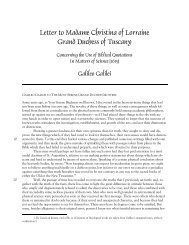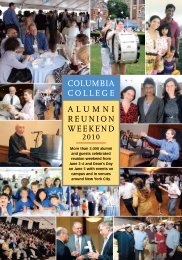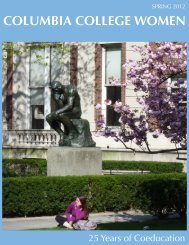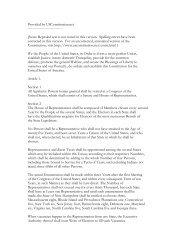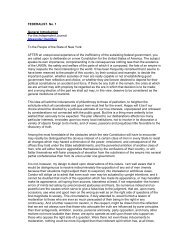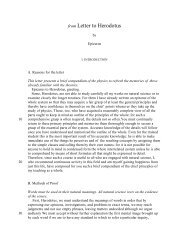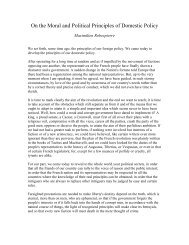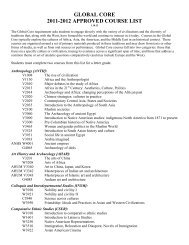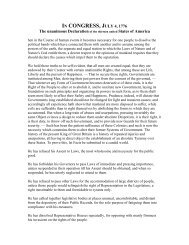A Passion for Science - Columbia College - Columbia University
A Passion for Science - Columbia College - Columbia University
A Passion for Science - Columbia College - Columbia University
You also want an ePaper? Increase the reach of your titles
YUMPU automatically turns print PDFs into web optimized ePapers that Google loves.
in 1965, Medicare and Medicaid were passed, Martin Luther<br />
King Jr. marched to Montgomery, Malcolm X was assassinated,<br />
President Lyndon B. Johnson’s Voting Rights Bill became<br />
law, more troops went to Vietnam and many were protesting<br />
the war. This was the social backdrop of our class.<br />
My years on Morningside Heights were a time of social change<br />
and student activism. The corner of West 116th Street and Broadway<br />
was as much a classroom as Hamilton Hall. Although premed,<br />
I minored in history. The highlight of my four years was Jim<br />
Shenton ’49’s renowned seminar “United States during the Era<br />
of Disunion.”<br />
Professor Shenton wove the milestones of current American<br />
history into his seminar, leaving me with indelible lessons of the<br />
tide of American history.<br />
I left Morningside Heights in June 1965. In September, I drove to<br />
St. Louis to begin my first year at Washington <strong>University</strong> Medical<br />
School. With Medicare and Medicaid promising access to care to<br />
millions previously excluded, I entered medicine believing that it<br />
would be a tool <strong>for</strong> social change.<br />
Quickly, I learned that the view from Morningside Heights<br />
was not that from the heartland. <strong>Columbia</strong> had prepared me well<br />
<strong>for</strong> medical school, but not that my profession’s vision of social<br />
responsibility started and stopped at the hospital’s door.<br />
Starving <strong>for</strong> the pulse of social change, I heard the words of my<br />
<strong>Columbia</strong> swimming coach, Richard Steadman: “Defeat is not a<br />
discouragement but a call to be better.” I started thinking of ways<br />
to get the medical school and hospital to extend its services to the<br />
inner city three miles from its door. With the support of two young<br />
faculty members, some of my classmates and members of the<br />
Pruitt-Igoe Men’s Club, we established a health center in Pruitt-<br />
Igoe, St. Louis’ largest public housing project.<br />
For the first 10 years after graduating from medical school, I<br />
a l u m n i C o R n e R<br />
MAY/JUNE 2011<br />
80<br />
<strong>Columbia</strong> CollEgE Today<br />
Caring <strong>for</strong> Those Without Health Insurance<br />
Dr. Ralph Freidin ’65 examines a patient at a free clinic in Washington,<br />
D.C., last August.<br />
PhOTO: ChRIS uShER<br />
B y dr. ra L P h Freidin ’65<br />
taught and practiced primary care and internal medicine in municipal<br />
hospitals. By 1980, I had a family of two young children and<br />
a wife with her own professional career. The problems of people<br />
marginalized in our health care system were too taxing <strong>for</strong> this<br />
stage of my life. I left inner-city medicine and joined a small private<br />
practice in Lexington, Mass.<br />
last summer, I saw a report of a one-day medical clinic in New<br />
Orleans that had provided free care to almost 1,000 people<br />
without insurance. The clinic, spread across 102,000 square<br />
feet of a convention hall, was my small neighborhood health center<br />
on steroids.<br />
Believing health care was a right of every American citizen, undoubtedly<br />
learned in CC, history classes and Professor Shenton’s<br />
Civil War seminar, I called The National Association of Free Clinics<br />
(NAFC, freeclinics.us). Two weeks later, I was on a plane to Little<br />
Rock. I was asked to triage the waiting line, looking <strong>for</strong> someone<br />
who needed urgent care. The people began to line up two hours<br />
be<strong>for</strong>e the doors opened at 10 a.m. By the time the first scheduled<br />
patient was seen, more than 200 patients were waiting.<br />
More than 80 percent were working but none had health insurance.<br />
Some were self-employed but could not af<strong>for</strong>d the premiums<br />
of individual policies. Some had several jobs, none of which<br />
provided health benefits. Others had been laid off and could not<br />
af<strong>for</strong>d COBRA.<br />
Few had seen a physician in the past year. Almost half had not<br />
seen a physician in the past six years. All had the same reasons <strong>for</strong><br />
having neglected their health. Without insurance, they could not<br />
af<strong>for</strong>d to pay <strong>for</strong> a physician visit. Without insurance, they could<br />
not af<strong>for</strong>d to fill their prescriptions. Without insurance, they could<br />
not af<strong>for</strong>d any surgical procedure. If they had been sick enough to<br />
need emergency care, they were then saddled with an enormous<br />
bill that discouraged them from seeking further care.<br />
A man with a below-knee amputation was in a wheelchair. He<br />
hoped the clinic would help him obtain the prosthesis request his<br />
medical insurance had denied.<br />
A woman grimacing in pain had cancer treatment two years<br />
ago but was unable to continue treatment without insurance.<br />
Another woman was wearing a trench coat to cover her emaciated<br />
frame. She had had three seizures in the past two weeks. A<br />
local emergency room where she had sought help told her that<br />
the level of her seizure medications was “OK” and discharged<br />
her. No follow up was arranged. During her seizures she had bitten<br />
the inside of her mouth and tongue. She could not eat. When<br />
I told her that we would care <strong>for</strong> her and arrange <strong>for</strong> further care,<br />
I could not see an intact tooth in her broad but crooked smile.<br />
A man with labored breathing and a sweaty brow was slumped<br />
in a wheelchair. His weak voice told me five days ago he was in the<br />
intensive care unit of a local hospital <strong>for</strong> “swollen legs and chest<br />
heaviness.” At discharge, he was handed a list of unaf<strong>for</strong>dable<br />
medications that he did not understand. Continuing care was not<br />
arranged. He had unstable angina. I wheeled him to the front of the<br />
line and called the EMTs to take him back to the hospital.<br />
(Continued on page 78)




